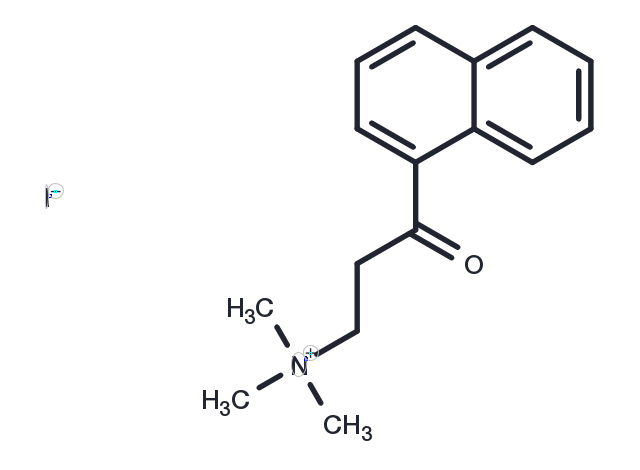Powder: -20°C for 3 years | In solvent: -80°C for 1 year


α-NETA is a potent and noncompetitive choline acetyltransferase (ChA) inhibitor with an IC 50 of 9 μM. α-NETA is a potent ALDH1A1 ( IC 50 =0.04 μM) and chemokine-like receptor-1 (CMKLR1) antagonist. α-NETA weakly inhibits cholinesterase (ChE; IC 50 =84 μM) and acetylcholinesterase (AChE; IC 50 =300 μM). α-NETA has anti-cancer activity [1] [2].

| Pack Size | Availability | Price/USD | Quantity |
|---|---|---|---|
| 25 mg | 6-8 weeks | Inquiry | |
| 50 mg | 6-8 weeks | Inquiry | |
| 100 mg | 6-8 weeks | Inquiry |
| Description | α-NETA is a potent and noncompetitive choline acetyltransferase (ChA) inhibitor with an IC 50 of 9 μM. α-NETA is a potent ALDH1A1 ( IC 50 =0.04 μM) and chemokine-like receptor-1 (CMKLR1) antagonist. α-NETA weakly inhibits cholinesterase (ChE; IC 50 =84 μM) and acetylcholinesterase (AChE; IC 50 =300 μM). α-NETA has anti-cancer activity [1] [2]. |
| In vitro | α-NETA (50-150 nM; 24 hours) decreases all cell lines viability in a dose-dependent manner [3]. α-NETA (2.5-10.0 μg/mL; 24 hours) leads to epithelial ovarian cancer (EOC) cell death associated with membrane blistering and cytoplasm leakage [3]. α-NETA treatment increases EOC cell expression of pyroptosis-associated proteins [3]. α-NETA is most potent in inhibiting aldehyde dehydrogenase 1 family, member A1 (ALDH1A1; IC 50 =0.04 μM; purified enzymes assay), followed by CMKLR1 (IC 50 =0.375 μM for β-ARR2 recruitment; Cell-based assay) and G9a histone lysine methyltransferase (IC 50 =0.50 μM; purified enzymes assay). α-NETA selectively inhibits chemerin-stimulated CMKLR1 association with β-arrestin2 [2]. α-NETA possesses fluorescent characteristics (excitation spectrum: maxima 255 and 297 nm; emission spectrum: maximum 437 nm) of naphthyl moiety [1]. Cell Viability Assay [3] Cell Line: Ho8910, Ho8910PM, A2780, and Iose80 cells Concentration: 50, 100, 150 nM Incubation Time: 24 hours Result: Decreased all cell lines viability in a dose-dependent manner. Apoptosis Analysis [3] Cell Line: Epithelial ovarian cancer (EOC) cell Concentration: 2.5, 7.5, 10.0 μg/mL Incubation Time: 24 hours Result: Led to EOC cell death associated with membrane blistering and cytoplasm leakage. |
| In vivo | Administration of α-NETA (intraperitoneally, i.p.; 0.125 mg/kg; once every other day over a span of 20 days) significantly reduced both the volume and weight of tumors in BALB/c nude mice with SKOV3 cells [3]. When injected subcutaneously (s.c.; at doses of 3 mg/kg or 10 mg/kg; daily for 30 days), α-NETA markedly delayed the onset of Experimental Autoimmune Encephalomyelitis (EAE) at a dosage of 3 mg/kg, and at 10 mg/kg, it completely halted the clinical symptoms for an average duration of nine days following the initial disease manifestation in control female C57BL/6 mice [2]. |
| Molecular Weight | 369.246 |
| Formula | C16H20INO |
| CAS No. | 115066-04-1 |
Powder: -20°C for 3 years | In solvent: -80°C for 1 year
You can also refer to dose conversion for different animals. More
bottom
Please see Inhibitor Handling Instructions for more frequently ask questions. Topics include: how to prepare stock solutions, how to store products, and cautions on cell-based assays & animal experiments, etc.
α-NETA 115066-04-1 inhibitor inhibit
